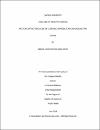Factors affecting dose of cardiac rehabilitation around the globe
| Advisor | Turk-Adawi, Karam |
| Advisor | Alam, Mohammed Fasihul |
| Author | Abu-Jeish, Abdel-Hadi Rushdi |
| Available date | 2018-12-12T11:25:49Z |
| Publication Date | 2018 |
| Abstract | Background: Cardiac Rehabilitation (CR) program promotes secondary prevention of cardiovascular disease. It is well-established that there is a dose-response association between CR participation and health outcomes. However, programs around the world are of varying durations, and sessions are offered at varying frequencies in each program. Objective: The aims of this study are to describe CR dose by country, World Health Organization’s (WHO) region, country income classification and global levels; and to determine factors that could affect the dose of CR worldwide. Method: This is a cross sectional study based on secondary data collected using Cardiac Rehabilitation Program Questionnaire developed by the International Council of Cardiovascular Prevention and Rehabilitation (ICCPR). Analyses included descriptive frequencies for the dose. A generalized linear model (GLM) used by applying generalized estimating equations to compare the dose among WHO regions and among income country groups, and to identify program -related factors (location of the program, payment, location of the program within hospital, presence of cardiologist, number of patients served in each session, presence of other program within 20 km, presence of any alternative models, funding of program) and patient related factors (type of diagnosis, level of risk) that might affect the dose of the CR program. Results: There was a significant difference between the six WHO regions (p-value <0.05), Americas had the largest dose with a mean of 3263.0 ± 2631.4 minutes, and South-East Asia had the smallest dose with a mean of 871 ± 542.3 minutes. The difference in the dose among the country -income groups was not significant (p-value 0.34). The following factors, among others, were positively associated with dose (p-value < 0.05): presence of cardiologist on the CR team (multiplicative effect on the mean [MEM], 1.29; 95% CI: 1.06 to 1.57), funding the CR program by a combination of governmental organizations and private health insurance (MEM, 1.27; 95% CI: 1.03 to 1.57), number of staff in the CR team (MEM: 1.17, 95% CI: 1.01 to 1.36), number of patients per session (MEM: 1.03, 95% CI: 1.01 to 1.04), and location of CR program (MEM:1.35, 95% CI:1.01 to 1.804). Conclusion: Both patient-related factors and organizational factors have key roles in doses of CR program. Findings of this study have important implications for the directors of CR program. These findings could guide decision-makers towards improving the dose of CR programs to achieve reductions in both mortality and morbidity associated with cardiovascular diseases. |
| Language | en |
| Subject | Cardiac Rehabilitation cardiovascular disease dose |
| Type | Master Thesis |
| Alternative Abstract | المقدمة: ان برنامج إعادة تأهيل مرضى القلب يعزز الوقاية الثانوية من أمراض القلب والأوعية الدموية. ومن المعروف أن هناك علاقة بين الجرعة التي يخضع لها مريض القلب في برنامج اعادة التأهيل والنتائج الصحية من هذا البرنامج. ومع ذلك ، فإن برامج التأهيل لأمراض القلب في جميع أنحاء العالم تقدم جرعات مختلفة لمرضى القلب. الهدف الرئيسي للدراسة: تهدف هذه الدراسة إلى وصف جرعة برامج التأهيل لمرضى القلب حسب البلد و حسب أقاليم منظمة الصحة العالمية و حسب التصنيف الاقتصادي للدول حول العالم. وتهدف الدراسة الى تحديد العوامل التي يمكن أن تؤثر على جرعة برامج اعادة التأهيل لمرضى القلب في جميع أنحاء العالم. منهج الدراسة: تعتمد على معلومات تم جمعها باستخدام استبيان برنامج التأهيل لمرضى القلب الذي طوره المجلس الدولي للوقاية من أمراض القلب وإعادة التأهيل لمرضى القلب و الأوعية الدموية. تحليل البيانات يتضمن تكرارات وصفية لجرعة برامج التأهيل. وتم تحليل البينات باستخدام النموذج الاحصائي (Generalized linear (model عن طريق تطبيق معادلات تقديرية لمقارنة الجرعة بين أقاليم منظمة الصحة العالمية وبين مجموعات البلدان حسب التصنيف الاقتصادي ، ولتحديد العوامل المرتبطة بالبرنامج التي قد تؤثر على جرعة البرنامج وهي )موقع الجغرافي لبرنامج اعادة التأهيل ، والموارد المالية للبرنامج ، و هل يقع البرنامج داخل المستشفى أم لا ، ووجود طبيب القلب في البرنامج ، عدد المرضى الذين تم تدريبهم في كل جلسة ، وجود برنامج آخر ضمن مسافة 20 كم ، وجود أي برامج بديلة في المنطقة ، التشخيص الطبي للمريض ، مستوى الخطورة لدى مريض القلب(. نتائج الدراسة: أثبتت الدراسة ان هناك اختلاف کبير في جرعة برامج التأهيل لمرضى القلب بين مناطق منظمة الصحة العالمية الستة (p-value <0.05) ، وکانت أمريكا الشمالية وأمريكا الجنوبية تمتلك الجرعة الأکبر بمتوسط 54 ساعة للبرنامج، وکانت جنوب شرق أسيا تمتلك الجرعة الأقل مع 15 ساعة للبرنامج. و أثبتت الدراسة انه لايوجد فرق في الجرعة بين المناطق المصنفة حسب الدخل الاقتصادي. وأثبتت الدراسة أن العوامل التالية ترتبط بجرعة برامج التأهيل بشكل ايجابي و هي: وجود طبيب القلب ضمن فريق برامج اعادة التاهيل ، تمويل برنامج اعادة التأهيل من خلال المنظمات الحكومية والتأمين الصحي الخاص مع ا ، عدد الموظفين في فريق برنامج التأهيل ، عدد المرضى في كل جلسة من برامج التأهيل ، وموقع برنامج التأهيل في المناطق الريفية. الاستنتاج من الدراسة : ان العوامل التي أثبتت هذه الدراسة ارتباطها بجرعة برامج التأهيل لمرضى القلب لها أدوار رئيسية ومهمة في تحسين برامج التأهيل لمرضى القلب. هذه النتائج قد توجه مدراء برامج التأهيل لتحسين جرعات برامج التأهيل لتحقيق تنائج صحية أفضل لمرضى القلب والأوعية الدموية. |
| Department | Public Health |
Files in this item
This item appears in the following Collection(s)
-
Public Health [44 items ]


